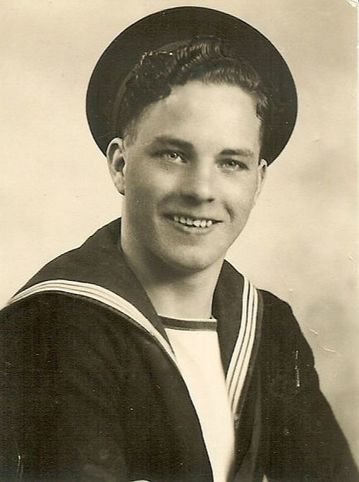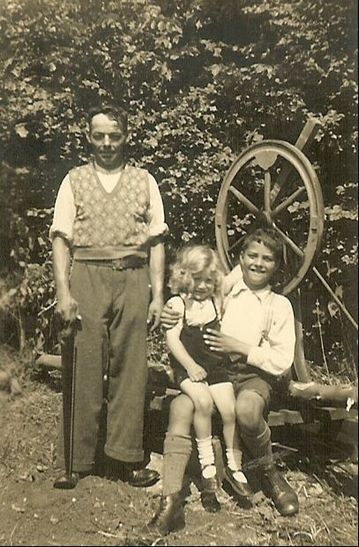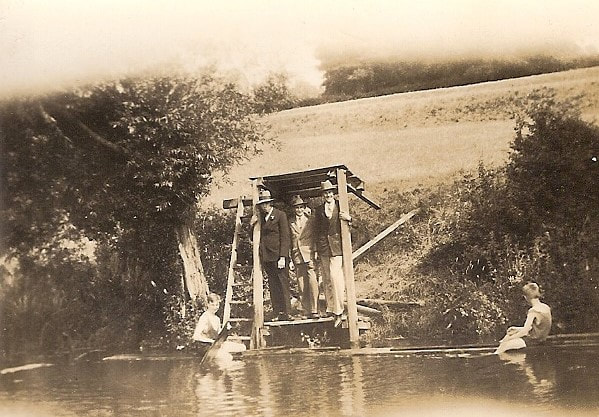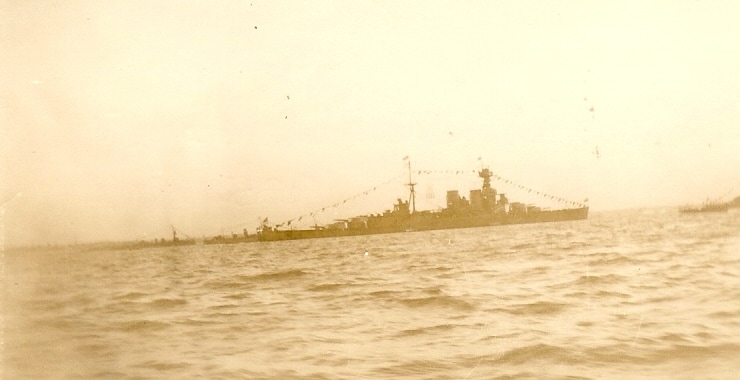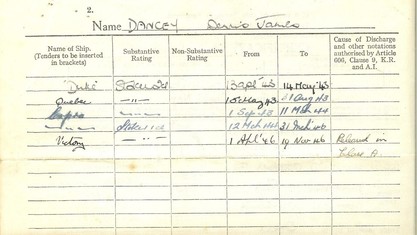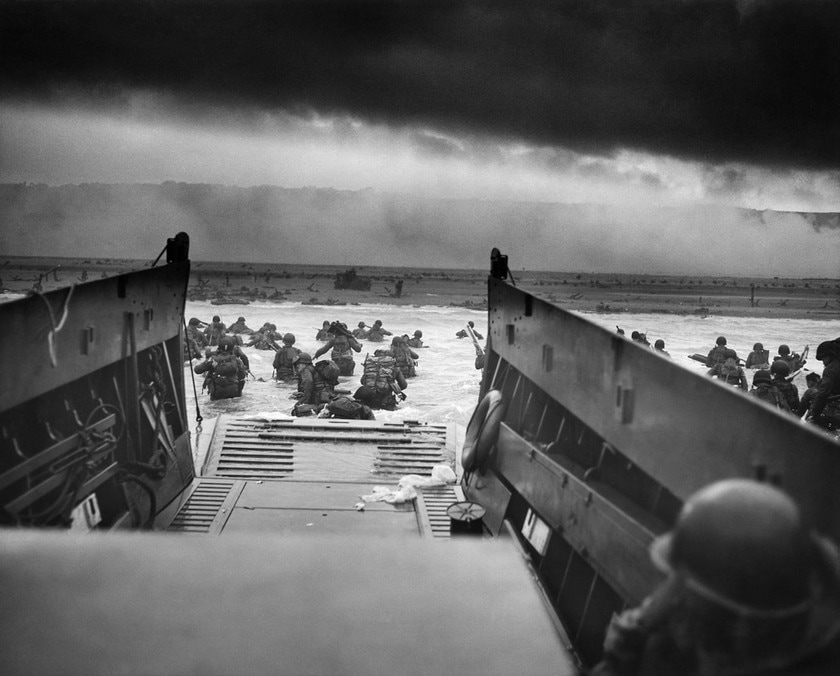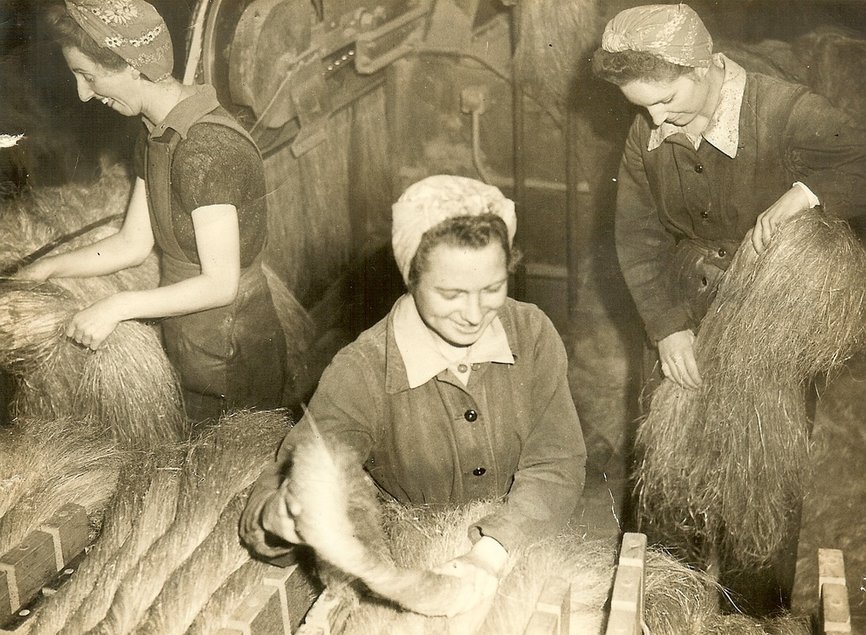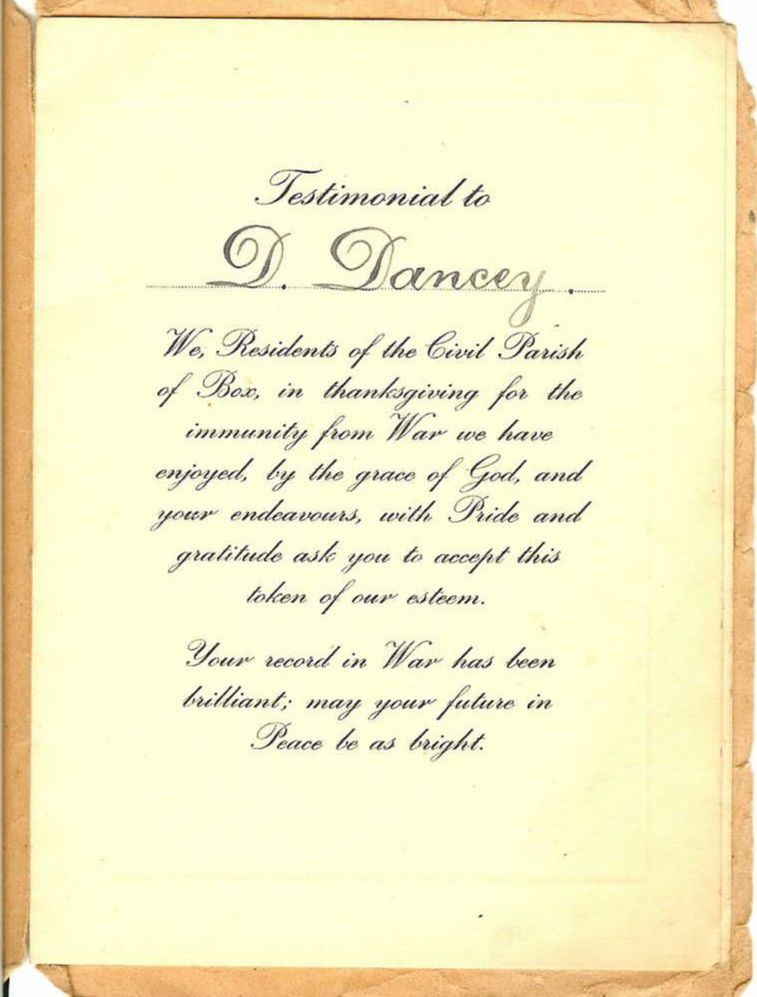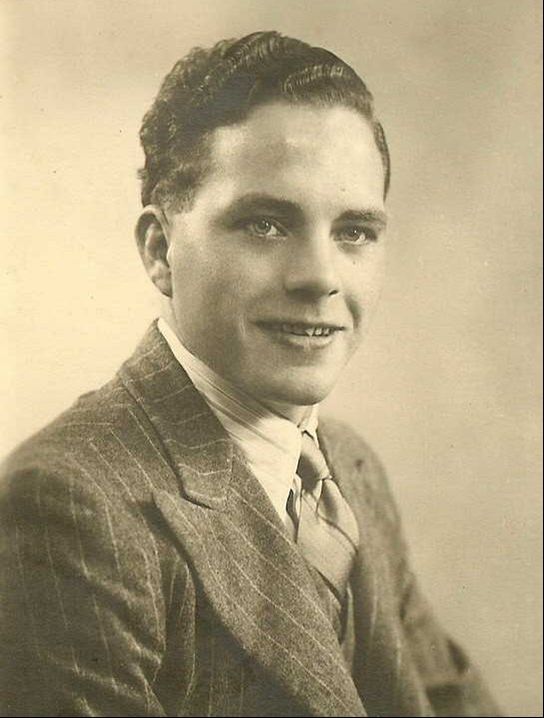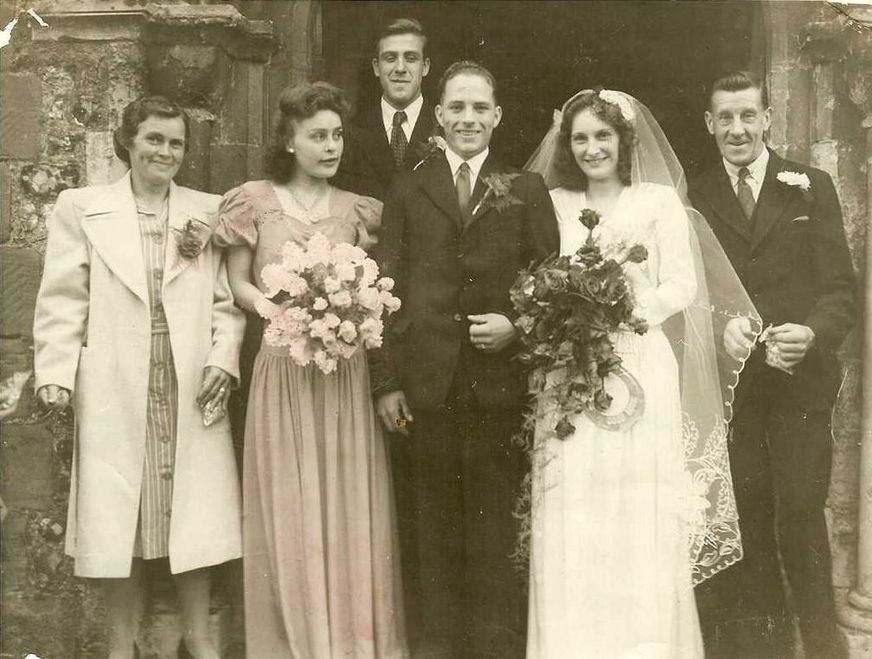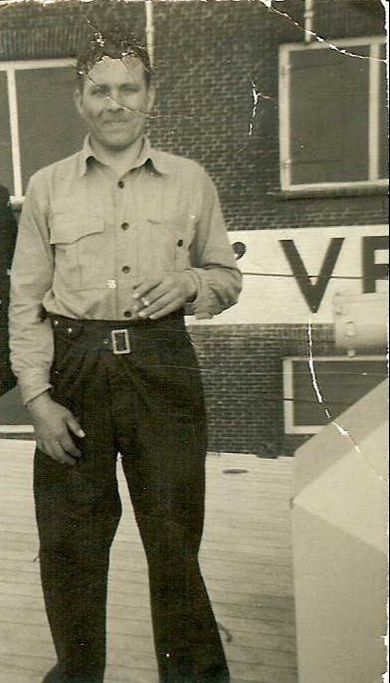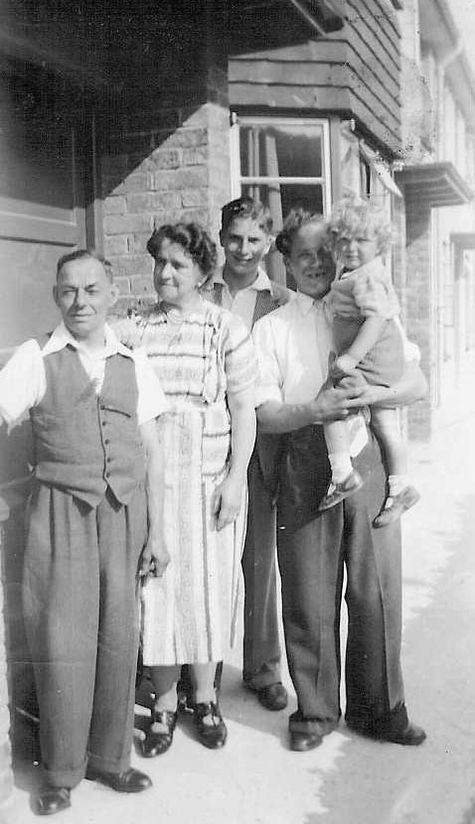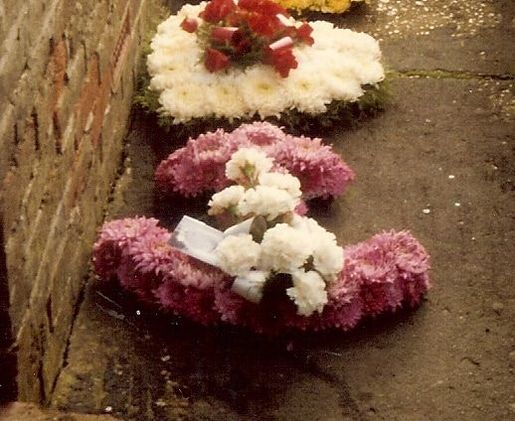|
Dennis (Curly ) Dancey, 1924 - 1981 During World War 2 Chris Dancey Family photos courtesy Chris Dancey April 2017 My father, Dennis James Dancey, was born in 1924 at one of the cottages at No Notion, off Box Hill on the eastern boundary of Box. My grandfather, James Warren Dancey, was employed on the farm there and Curly grew up at No Notion until the family moved to 7 Market Place in the centre of the village. As a child, my father had blond, curly hair (which interestingly I also inherited) and he was always known as Curly to his friends and workmates. Left: Curly joined the Royal Navy in April 1943 |
Early Years
The photograph below shows the male members of my family before the Second World War. Left to right are grandfather James Warren Dancey, uncle Donald as a child and my father on the right, all sitting around a well. On the reverse, in my grandmother's handwriting, it has Mrs Foster's Powlilea and in my father's writing about 1936. Mrs Foster and her daughter, Nell, lived at Powlilea well into the 1940s and my grandmother used to clean their house. My uncle Les remembers sitting in the kitchen when Mrs Foster was making scones. We believe that Nell, the daughter, was an illustrator for books or magazines.
The photograph below shows the male members of my family before the Second World War. Left to right are grandfather James Warren Dancey, uncle Donald as a child and my father on the right, all sitting around a well. On the reverse, in my grandmother's handwriting, it has Mrs Foster's Powlilea and in my father's writing about 1936. Mrs Foster and her daughter, Nell, lived at Powlilea well into the 1940s and my grandmother used to clean their house. My uncle Les remembers sitting in the kitchen when Mrs Foster was making scones. We believe that Nell, the daughter, was an illustrator for books or magazines.
|
Father liked an organised, structured environment, which is possibly why he very much enjoyed his time in the Box Scouts. In the photo below he is shown third from the left in the middle row aged about twelve years, in the Bingham Hall, Box.
Apart from my father, I don't know the names of any of the people, but I am interested if any readers can identify these Box residents from the 1930s. |
Below left is a photo given to my Father by his friend, a Box resident, who was lost on HMS Hood on 24 May 1941. It shows the Mighty Hood at Spithead on 16 July 1935. I do not know the name of father's friend, only that his sacrifice was the reason why father wanted to serve in the Royal Navy. Maybe someone knows who this may have been?
Training for Active Duty
Dad was only 15 years-old when war broke out, too young to be called up for military service. He joined the Royal Navy on 13 April 1943 and served at HMS Duke , the basic training establishment at Malvern where he learnt to be a stoker, which at that time was no longer a coal-shoveller but a person responsible for maintaining the boiler in the engine room. An extract of his service record is shown above right.
On the 15 May 1943 he transferred to HMS Quebec, the No 1 Combined Operations Training Centre, at a secret location at Inveraray, Scotland. CTC Inveraray was set up in October 1940 for the training of commando units, brigade groups in the assault role and naval landing craft crews. Father mentioned that life at the camp was rigorous and meagre. He was transferred to COPRA (Combined Operations Personnel Records & Accounts) on 1 September 1943 until March 1944, training for the eventual Operation Overlord, D-Day invasion at Normandy, France. Whilst serving for COPRA, Curly was promoted to Engineering Mechanic 1 on the 12 March 1944.
Dad was only 15 years-old when war broke out, too young to be called up for military service. He joined the Royal Navy on 13 April 1943 and served at HMS Duke , the basic training establishment at Malvern where he learnt to be a stoker, which at that time was no longer a coal-shoveller but a person responsible for maintaining the boiler in the engine room. An extract of his service record is shown above right.
On the 15 May 1943 he transferred to HMS Quebec, the No 1 Combined Operations Training Centre, at a secret location at Inveraray, Scotland. CTC Inveraray was set up in October 1940 for the training of commando units, brigade groups in the assault role and naval landing craft crews. Father mentioned that life at the camp was rigorous and meagre. He was transferred to COPRA (Combined Operations Personnel Records & Accounts) on 1 September 1943 until March 1944, training for the eventual Operation Overlord, D-Day invasion at Normandy, France. Whilst serving for COPRA, Curly was promoted to Engineering Mechanic 1 on the 12 March 1944.
Whilst training in Scotland, Curly told me that he had a lucky escape. His training was involving the engine room maintenance and operation of an LCT (Tank Landing Craft). At this time it was decided to convert three standard LCTs into gunships as an experiment. They mounted a large gun on the deck of each LCT and as such, the craft was top heavy. The LCTs were required to be moved down to the South Coast and crews were selected for this duty, Father was on leave during this selection. The LCTs left Scotland via the North Sea on the route south, a storm blew in and all three were lost with a significant loss of life, they were too top heavy and with the flat bottom, shallow draught, they succumbed. The idea was hastily dropped !
Meeting My Mother
During May 1944, after further training and exercises, his LCT was sent in convoy down to Newhaven, East Sussex, where they would be based in the lead up to the 6 June D-Day operations. Father told me that they were usually confined to their ships as there were concerns about information being leaked and the enemy getting to know what was about to happen. The crews however were allowed some time ashore. Father and his radio operator friend from their LCT decided to go to Lewes, which is seven miles from Newhaven for a change of scenery. They were both in uniform as this was standing orders. When they entered a pub they spotted a couple of young ladies at the bar, one of them took my father's eye and they soon were in conversation. The ladies were sisters, the elder sister, Susan Jane Fuller Roberts, was just about to go on her war-duty night shift and was relaxing by having a drink before starting the night's work.
Susan handed Curly her address and made plans to meet again. Later Curly told Susan that at some point he would be going on ops, didn't know where or when. By then they had struck up a relationship and as time passed they got to meet on a regular basis during the bits of shore leave. Curly told Susan that, when he had to go over there, he would get a message to her somehow. This was around the end of May or the beginning of June 1944.
Wartime Experiences
Two incidents involving Curly were relayed to me not by him but by my mother. Both were during WW2, the first whilst Curly was in Portsmouth Harbour. Orders were given that his LCT was to be loaded with Royal Marines, that they were not to carry rifles or firearms, just large spanners and other impact weaponry. Curly was to equip himself in the same manner. It would appear that a US warship, probably a cruiser, had a problem on board with mutinous crewmen. The marines were to deal with the insurgency, which they did by physical means. Next day, when the cruiser set sail, many of the deck crew were seen to be sporting bandaged heads and arms in slings. Mother always said it was termed Hands across the Ocean.
The second incident was at Portland. Father used to box in the navy (uncle Don and uncle Les also boxed in the army). Curly and a Commando pal were out on leave in civvies when they were accosted by half a dozen spivs, as mother called them. The head spiv, who was smoking a cigarette in a holder, demanded money, which was ignored by Curly and friend. The head spiv went to punch one of them but ended up flat on his back with the cigarette holder bitten in half. Mother said it was the commando's friend, but it turned out that all six spivs ended up worse for wear, they obviously had picked on the wrong two !! I did speak to my father about the incident, but in his mild manner he just said There was a War on! Apparently the punch to the jaw of the head spiv's jaw had resulted in his biting through the holder.... ouch !!
During May 1944, after further training and exercises, his LCT was sent in convoy down to Newhaven, East Sussex, where they would be based in the lead up to the 6 June D-Day operations. Father told me that they were usually confined to their ships as there were concerns about information being leaked and the enemy getting to know what was about to happen. The crews however were allowed some time ashore. Father and his radio operator friend from their LCT decided to go to Lewes, which is seven miles from Newhaven for a change of scenery. They were both in uniform as this was standing orders. When they entered a pub they spotted a couple of young ladies at the bar, one of them took my father's eye and they soon were in conversation. The ladies were sisters, the elder sister, Susan Jane Fuller Roberts, was just about to go on her war-duty night shift and was relaxing by having a drink before starting the night's work.
Susan handed Curly her address and made plans to meet again. Later Curly told Susan that at some point he would be going on ops, didn't know where or when. By then they had struck up a relationship and as time passed they got to meet on a regular basis during the bits of shore leave. Curly told Susan that, when he had to go over there, he would get a message to her somehow. This was around the end of May or the beginning of June 1944.
Wartime Experiences
Two incidents involving Curly were relayed to me not by him but by my mother. Both were during WW2, the first whilst Curly was in Portsmouth Harbour. Orders were given that his LCT was to be loaded with Royal Marines, that they were not to carry rifles or firearms, just large spanners and other impact weaponry. Curly was to equip himself in the same manner. It would appear that a US warship, probably a cruiser, had a problem on board with mutinous crewmen. The marines were to deal with the insurgency, which they did by physical means. Next day, when the cruiser set sail, many of the deck crew were seen to be sporting bandaged heads and arms in slings. Mother always said it was termed Hands across the Ocean.
The second incident was at Portland. Father used to box in the navy (uncle Don and uncle Les also boxed in the army). Curly and a Commando pal were out on leave in civvies when they were accosted by half a dozen spivs, as mother called them. The head spiv, who was smoking a cigarette in a holder, demanded money, which was ignored by Curly and friend. The head spiv went to punch one of them but ended up flat on his back with the cigarette holder bitten in half. Mother said it was the commando's friend, but it turned out that all six spivs ended up worse for wear, they obviously had picked on the wrong two !! I did speak to my father about the incident, but in his mild manner he just said There was a War on! Apparently the punch to the jaw of the head spiv's jaw had resulted in his biting through the holder.... ouch !!
Above: Actual photo of the landing at Omaha called Into the Jaws of Death by Robert F Sargent (courtesy Wikimedia)
D Day Operations
On the 4 June Curly was told that all shore leave was cancelled and preparations were underway for the invasion to start even though the weather was rough and conditions not good. It was at this time that Curly sent a radio message (via his radio operator friend) to Lewes Police Station, to send a message to Susan's house saying We are off. Surprisingly this was not censored and the station sent a constable to Susan's house with the brief message.
Curly told me that they joined the main group of assault craft after picking up a large quantity of US Rangers. There were no tanks, just troops, many of whom were in a bad way with seasickness on the crossing. Curly was in the engine room for what seemed liked hours. The next he knew was hearing gunfire and explosions, and bullets ricocheting off the hull. Some of the bullets spat a small piece of white hot steel into the engine room, he crouched behind the main engine to stay safely out of the way of this molten steel. When he did get back on deck, he crouched down between the AA turret and bulkhead and could see through a small gap what was happening. They were heading towards a US beach that was heavily under fire, the beach was being raked by machine gun fire and the invading troops' losses were significant. They hit the beach, off-loaded the US Rangers into the withering fire. The casualties were piling up and, as soon as they could, they reversed the engines to go and collect the next batch. They made three beach landings that day, the 6 June 1944. Curly got to know later that this was indeed Omaha Beach.
Omaha Beach was a vital point in the Normandy invasion plan because the area joined the British landings at Gold Beach with the American forces at Utah. The military action did not go well. For fear of hitting their own troops, bombing by the Allies was totally inadequate, the sea was very rough and seasickness afflicted most servicemen. Under heavy German fire the initial assault was unsuccessful and a second invasion wave had to be conducted. The taking of Omaha was precarious and, at times, it looked as though it was going to be abandoned. In the end the invasion was successful with the loss of about 5,000 servicemen but, fortunately, my dad survived.
After the invasion, Curly's LCT was scheduled, along with others, to sail up and down the coastline to collect the wounded from the inland fighting and also deceased troops that were in the water and on the shoreline and to ferry them to the hospital ships waiting offshore. Subsequent to this, the next duty of the LCT was to ferry Nazi prisoners back to the liberty ships. One German officer asked Curly if he could buy a cigarette. Curly gave him a cigarette for nothing and the officer gave Curly a Nazi Party badge in payment, which I still have.
Curly always told me that it was British landing craft and sailors, who had manned them, not as in the film Saving Private Ryan, which showed US sailors. He would not have liked that.
On the 4 June Curly was told that all shore leave was cancelled and preparations were underway for the invasion to start even though the weather was rough and conditions not good. It was at this time that Curly sent a radio message (via his radio operator friend) to Lewes Police Station, to send a message to Susan's house saying We are off. Surprisingly this was not censored and the station sent a constable to Susan's house with the brief message.
Curly told me that they joined the main group of assault craft after picking up a large quantity of US Rangers. There were no tanks, just troops, many of whom were in a bad way with seasickness on the crossing. Curly was in the engine room for what seemed liked hours. The next he knew was hearing gunfire and explosions, and bullets ricocheting off the hull. Some of the bullets spat a small piece of white hot steel into the engine room, he crouched behind the main engine to stay safely out of the way of this molten steel. When he did get back on deck, he crouched down between the AA turret and bulkhead and could see through a small gap what was happening. They were heading towards a US beach that was heavily under fire, the beach was being raked by machine gun fire and the invading troops' losses were significant. They hit the beach, off-loaded the US Rangers into the withering fire. The casualties were piling up and, as soon as they could, they reversed the engines to go and collect the next batch. They made three beach landings that day, the 6 June 1944. Curly got to know later that this was indeed Omaha Beach.
Omaha Beach was a vital point in the Normandy invasion plan because the area joined the British landings at Gold Beach with the American forces at Utah. The military action did not go well. For fear of hitting their own troops, bombing by the Allies was totally inadequate, the sea was very rough and seasickness afflicted most servicemen. Under heavy German fire the initial assault was unsuccessful and a second invasion wave had to be conducted. The taking of Omaha was precarious and, at times, it looked as though it was going to be abandoned. In the end the invasion was successful with the loss of about 5,000 servicemen but, fortunately, my dad survived.
After the invasion, Curly's LCT was scheduled, along with others, to sail up and down the coastline to collect the wounded from the inland fighting and also deceased troops that were in the water and on the shoreline and to ferry them to the hospital ships waiting offshore. Subsequent to this, the next duty of the LCT was to ferry Nazi prisoners back to the liberty ships. One German officer asked Curly if he could buy a cigarette. Curly gave him a cigarette for nothing and the officer gave Curly a Nazi Party badge in payment, which I still have.
Curly always told me that it was British landing craft and sailors, who had manned them, not as in the film Saving Private Ryan, which showed US sailors. He would not have liked that.
Back Home
Below is a photograph taken in 1945, showing my mother on the right working in a factory at Buxted, Near Uckfield, East Sussex. During the war she was the night manager responsible for making parachute harness out of flax. The lady in the front is folding the flax into sheaths, which would then be woven to produce the harness. The parachutes themselves were made in another factory nearby.
Below is a photograph taken in 1945, showing my mother on the right working in a factory at Buxted, Near Uckfield, East Sussex. During the war she was the night manager responsible for making parachute harness out of flax. The lady in the front is folding the flax into sheaths, which would then be woven to produce the harness. The parachutes themselves were made in another factory nearby.
Having been given the message by the police that Curly was over there, Susan waited in the window of her mother's house in Lewes every day, looking and waiting for her sailor to come. She was working nights making parachute harness and during the day she waited up to hear news of the invasion and whether Curly had made it back. This went on for nearly a month. Susan was so tired from lack of sleep and the work, she fell asleep sat in the window, when there was a knock on the door. Susan's mother opened the door to a sailor carrying his kitbag and Curly woke up his now fast-asleep girlfriend.
My father was given a certificate from Box for his war service (below left). His war record showed him as Stoker 1st Class. Below right is my father's demob photo, which was taken for my mother on their engagement 19 November 1946.
My father was given a certificate from Box for his war service (below left). His war record showed him as Stoker 1st Class. Below right is my father's demob photo, which was taken for my mother on their engagement 19 November 1946.
Needless to say they got married. My mum and dad's wedding was on 28 June 1947 at St Anne's Church, Lewes, East Sussex. The best man was father's RN radio operator friend from when they had served together on a LCT. Mum made her own wedding dress from silk parachute material. I was born on the 1 May 1948.
Mum and Dad's wedding photo with left to right: My maternal great aunt Susan, bridesmaid aunt Daisy (my godmother), best man behind, father's RN radio operator friend, name unknown, father and mother, right Mr Piper, a widower neighbour of my grandmother, who would always be on hand to help our family.
Love of the Sea
Father joined the RNVR (Royal Navy Volunteer Service, later Royal Navy Reserve) in 1953. He served part-time at HMS Sussex, Shoreham, the RNR Sea Training Centre, where HMS Curzon, a ton class coastal minesweeper, was based. Father was the Chiefy, Chief Engineer, and was responsible for the ship's engines and other equipment.
Father joined the RNVR (Royal Navy Volunteer Service, later Royal Navy Reserve) in 1953. He served part-time at HMS Sussex, Shoreham, the RNR Sea Training Centre, where HMS Curzon, a ton class coastal minesweeper, was based. Father was the Chiefy, Chief Engineer, and was responsible for the ship's engines and other equipment.
|
The ship had an interesting history. It was launched in 1954 and was renamed HMS Fittleton, named after a village near Salisbury, Wiltshire. It ended its days by turning turtle (upside down) at sea in a heavy swell in 1976, when twelve servicemen lost their lives, the largest loss in peacetime service by the RNR. Minesweepers with their wooden hullswere top-heavy (to avoid attracting magnetic mines under the sea surface), which made them unstable in rough water.
He was an ME1 stoker (Metalsmith Petty Officer first class) and, as a young man, I went on board with him a few times. He showed me round the Curzon's two Deltic diesel engines, which he would fire up using a cartridge like a shotgun. Dad loved the sea and always wanted to go sailing when he retired. We intended to buy a yacht together so we could sail and he asked me to take the sailing exams with the RYA (Royal Yacht Association), which I did to yacht-master level. Dad wasn't keen on the academic lessons, just wanted to sail, but he took the exams for Stoker CPO (Chief Petty Officer) and I helped him with the mathematics. He would often go to sea for training and goodwill trips to other destinations, such as the Channel Islands, France and Netherlands, where he got merry at the De Kuypers Liquor establishment, he told me. I had the pleasure to go down in the engine room on open days, sporting my ear defenders (the noise was deafening), watching test firing of the bofors deck gun and bringing home the shell case. Every year there was a Christmas Party for the children of the officers and crew. |
Father retired from the RNR on 6 November 1963 when my mother became ill and she needed to be hospitalised for some time. Father loved the RN, and the sea.
|
Later Life
I can recall father playing football as part of a local team in Lewes, East Sussex where he set up home with my mother. His love of the sea kept him down there and, although he always had fond memories of Box village, he never lived there again. My grandparents, Jim and Kate Dancey, used to visit our house in Lewes. The photo left dates from about 1952 or 1953 and also shows uncle Donald. Father, who had lost his front teeth and was waiting for a replacement set, is carrying me with my blond locks. It was just before we moved to a larger house in Lewes to be near my maternal grandmother and aunts. Father died on Friday 13 November 1981. His shipmates at HMS Sussex sent him a tribute wreath in the shape of an anchor (below). He would have been very proud of this. |
We would love to hear from anyone with their memories of World War 2 and people at that time, as part of a future series on the history of Box and its residents during that time. And Chris would welcome the names of the scouts in the photo of his father.
